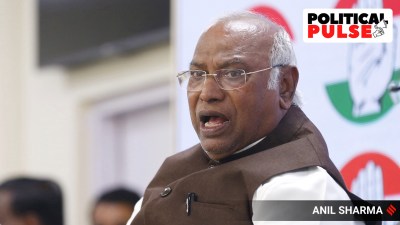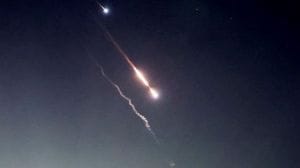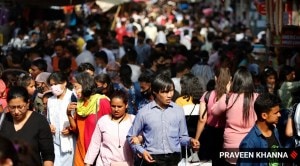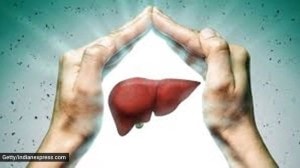- India
- International
A tale of two towns
Closer to Raxaul, the dirt track gives way to pools of rain water.
 The 68-kilometre national highway is mostly a dirt track near Raxaul. (Source: Express photo Prashant Ravi)
The 68-kilometre national highway is mostly a dirt track near Raxaul. (Source: Express photo Prashant Ravi)
As PM Narendra Modi lands in Kathmandu today, RAKESH SINHA hits NH28-A, a dirt track that leads to Raxaul, the last town on the Indian side of the border with Nepal, crosses over through the open border to Birgunj, the bustling town that lies on the other side, and finds that 3 km can mean a world of difference. Photographs by Prashant Ravi.
Long hauls don’t tire Habib Sheikh. From Guntur in Andhra Pradesh, he makes his runs, driving his truck across states, never asking questions why people order what they do. He does what he is told: drop the consignment, get back, prepare for the next run. The cargo of red chillies turns his eyes red, flares the nostrils, but he never complains. It is the only job he knows, one which keeps the family going. Yet Habib despairs each time he is told to head to Raxaul, a town in Bihar which sits on the Nepal border and is 200 km from state capital Patna. Because 30 km before Raxaul, the NH-28A disappears and morphs into a dirt track, the clouds of dust forcing him to peer through the windscreen. Pebbles fly dangerously from beneath the tyres as he drives past boards which say work on the national highway is in progress. But he recalls having seen the boards on his earlier runs. The road looks the same.
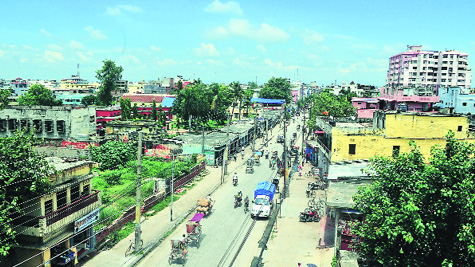 Bustling Birgunj is the commercial capital of Nepal. An industrial corridor stretches from here to Pathlaiya.
Bustling Birgunj is the commercial capital of Nepal. An industrial corridor stretches from here to Pathlaiya.
Closer to Raxaul, the dirt track gives way to pools of rain water. Slush leaps on to his truck as tankers, container carriers, jeeps race past to join the queue to enter Birgunj, the gateway to Nepal. Habib too joins the race, slowing down only when he enters Raxaul bazaar. He knows the wait to the border check point has begun. “The last time I was here, the queue was so long that I had to wait five days to enter Birgunj. Hopefully, I will get there sooner this time. Why can’t they fix this road, make the border crossing simpler?”
 The 68-kilometre national highway is mostly a dirt track near Raxaul.
The 68-kilometre national highway is mostly a dirt track near Raxaul.
The queue to Birgunj is already 3 km long, packed with smoke-belching oil tankers, emulsion tankers, LPG tankers, trucks carrying spices, and goods that you and I need routinely, daily. The registration plates tell you that they are from every part of the country — Andhra Pradesh, West Bengal, Nagaland, Uttar Pradesh, Haryana, Gujarat, Rajasthan, the list as long as the queue, and in no order. The tankers and trucks snake through the town, taking up half the road and leaving the other half to a two-way traffic of rickshaws, cycles, motorcycles, Boleros, Scorpios. If the honks and yells don’t upset you, the stench from the overflowing drains will. So will the heaps of garbage, vegetable waste lining the road.
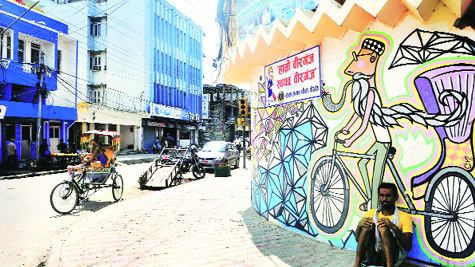 Birgunj has regulated traffic, own FM station, busy bazaars and a medical college that draws students from Bihar.
Birgunj has regulated traffic, own FM station, busy bazaars and a medical college that draws students from Bihar.
This is the lifeline of Nepal, the NH-28A which accounts for 70 per cent of trade between the two neighbours — and the one gateway to Nepal which Prime Minister Narendra Modi will not see when he lands in Kathmandu on Sunday to improve ties with a country which has not had an Indian prime minister calling in 17 years. Inder Kumar Gujral visited Nepal in 1997 and Atal Bihari Vajpayee only for the SAARC Summit in 2002.

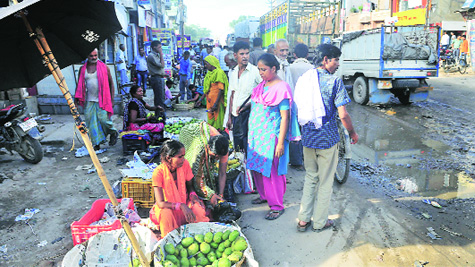 The wait to border check point begins from Raxaul bazaar, with traders from Nepal shocked at the mess.
The wait to border check point begins from Raxaul bazaar, with traders from Nepal shocked at the mess.
The 68-km-long NH-28A connects the towns of Pipra and Raxaul in East Champaran district. Tantia Constructions is tasked with constructing the highway from Piprakothi but the town itself lies ignored.
Raxaul is a picture of urban decay, of a hopelessness no border town knows, long forsaken by the State, and left to wallow in its squalour. The district administration sits 50 km away in Motihari, a two-and-half hour ride on what passes for a national highway.
Bimal Rungta, whose family runs the Amardeep clothes showroom in a lane off Lohapatti Road, says he prefers to walk and take a rickshaw to Birgunj across the border. “It can take you three hours by car to cover 3 km to Birgunj. Given that crores are made through trade via Raxaul, this town should have had a VIP road.”
Rungta, who is also the secretary of the Raxaul textile chamber of commerce, says the town has 12 hours of power cuts everyday. “I have installed three generator sets to keep my showroom going.” The town has no decent school or college, no family restaurant, not even a park where children can spend an afternoon. Most in town prefer to give the local cinema hall a miss. “This is no place to bring up children. I have sent my son to Bangalore where he studies in Class XII,” says Rungta.
His brother Pradeep left Raxaul for Surat five years ago, and is currently visiting Bimal. “I handle the Surat operations of the family business. My son Chetan helps Pradeep here. You can’t compare life in Surat with what we have here.” He pulls out a cellphone and shows a video clip of highrises, broad roads, gleaming cars. Surat is a world removed.
In the bazaar, traders speak in unison: “Raxaul has known nothing except despair. The integrated check point at the border is still to come up. We thought the rail upgrade after the gauge conversion from Darbhanga to Raxaul via Sitamarhi would help change lives. But now the gates remain shut because more trains have to pass through. There is no sign of the overbridge that was promised. How can we prosper if we have to wait so long for wholesalers from Birgunj to come and buy our goods?”
***
Prosperity lies 3 km away, across the open border. Bustling Birgunj is Nepal’s commercial capital, the second largest city in the country after Kathmandu. Like every boomtown, it has its share of problems, power cuts and an infrastructure struggling to cope with the demands of a growing population, fuelled by migrants in search of jobs.
But there is an air of optimism. An industrial corridor is stretching out to Pathlaiya, more and more firms are investing in textile, steel, cigarettes, cement, pharmaceuticals, even ghee. Unlike Raxaul, Birgunj has traffic under control, enforced strictly by policemen on the roads. Its hotels and restaurants, not in the same league as the ones in Kathmandu, are packed, offering clean rooms and decent meals. Mobile service provider Ncell does brisk business, offering pre-paid SIM cards to tourists and travellers who have proper identification papers. The town has its own FM station, its bazaars are busy, and the schools alive. Many from Bihar study at the medical college in Birgunj. There is even an airport at Simara with daily flights to Kathmandu. Those who prefer the road take the Tribhuvan highway to Kathmandu, covering 180 km in a little over four hours. A shorter ride is via Hetauda and the Kulekhani hydel power station.
India has a consulate in Birgunj, tasked with the implementation and monitoring of assisted projects in eight districts under its jurisdiction — Parsa, Bara, Chitwan, Sarlahi, Dhanusha, Rautahat, Makwanpur and Mahottari. These are essentially small development projects, little steps to help Nepal shut out its recent past, the sufferings of a decade-long insurgency followed by a political uncertainty that refuses to die.
Yet Birgunj can’t fathom why India has abandoned Raxaul. “Border towns are mirrors. They create first impressions, so they should be managed well. Many in Nepal who have never seen a railway train go to Raxaul to travel to towns in India. But quite a few return, shocked by the filth at the railway station, the mess in the town. Is this what India looks like, they ask. How do I explain your metros to them if their first impression of India is so negative? We are well-wishers of India, you can even call us her ambassadors. But this doesn’t help. How can it take so long to fix a border road? Thirty trucks bring my goods every month. Each takes four days to cross the border,” says Ashok Kumar Temani, chairman of the Yash Group which trades in industrial chemicals and hardware, and manufactures candies and bubble gum.
An executive member of the Federation of Nepal Chamber of Commerce and Industries (FNCCI), Temani led a delegation to New Delhi last September: “I even suggested to our counterparts in FICCI that they open an office on the Raxaul-Birgunj border to get first-hand account of the problems we face. We met Indian government officials, told them how the conditions in Raxaul were hurting not just Birgunj but all of Nepal.”
Sunil Kumar Kanth and Manoj Upadhyay of the Birgunj Chamber of Commerce and Industries agree with Temani. “It is the most active point on the Indo-Nepal border. India is upgrading roads everywhere. But look at NH-28A, it’s laughable. It affects not just business and trade but our social, cultural, religious and political ties. Pilgrims use this border, people from Nepal go to India for medical treatment. The least they can do is expedite the road work and clearance of goods,” says Upadhyay. He estimates that 1,000 to 1,200 trucks enter Birgunj everyday.
In February this year, chamber officials met MPs on the Indian side of the border and signed “a memorandum of understanding to work together to resolve issues”. These included making the Raxaul airstrip operational, expediting work on the integrated checkpost, building an overbridge at the Raxaul railway crossing, developing the railway station with trains for other destinations in India, and curbing crime in the two border towns by posting an SP-rank officer in Raxaul.
Indian officials admit Raxaul desperately needs a facelift, especially the highway stretch from Motihari, to fast-track border movements. Work on the integrated checkpost hasn’t quite moved at the pace it should have. But they point to the dry port established in Birgunj for handling of goods. Bilateral trade takes place in Indian rupee or convertible currency. The Nepal Rastra Bank has had a fixed exchange rate since 1993: 1 INR=1.6 NR.
Traders in Birgunj track developments in India very closely. They are counting on the regime change in Delhi, and Modi’s visit to Nepal, to bring some cheer to this border crossing. “India needs to invest not just in Nepal, but also in its border towns. It will help transform our country. If they don’t do that, acchhe din kaise aayenge? Not on this side, nor across the border,” says Upadhyay.
Waiting in his truck in Raxaul, Habib Sheikh cannot agree more.
Apr 19: Latest News
- 01
- 02
- 03
- 04
- 05











